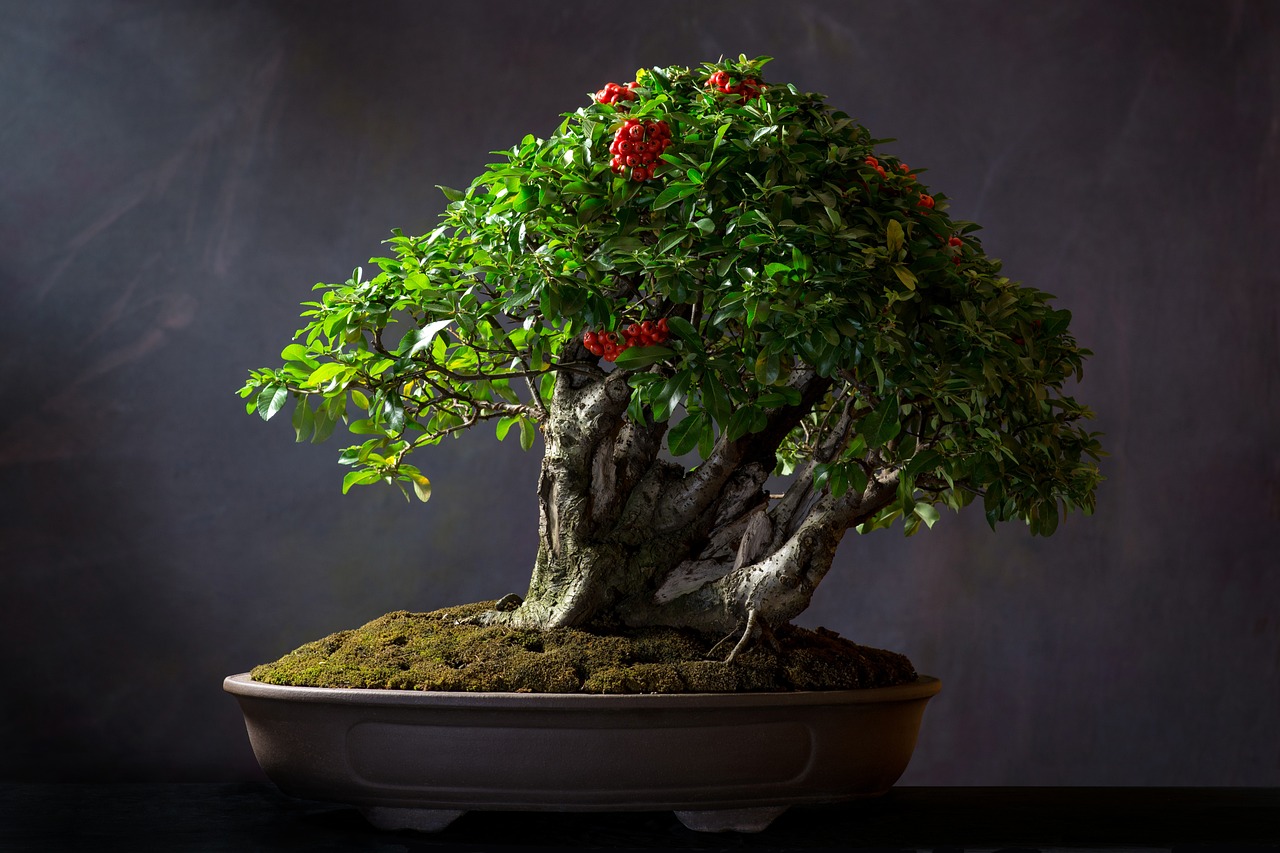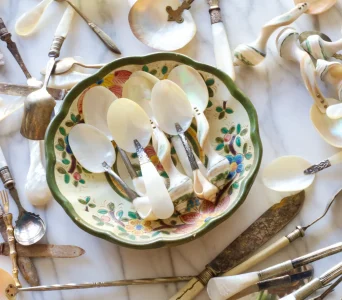 Pin
Pin Photo courtesy of Melissa Parks
Things that come from the ocean have a way of making the ordinary world feel a bit upside-down, don’t they? You reach for a spoon, expecting cold metal, and instead your fingers meet something smooth and warm that shimmers like soap bubbles. That’s the strange delight of holding something carved from a shell that once housed a creature who never imagined its home would one day serve tea or hold paper clips.
The truly wonderful part is how these pieces refuse to choose between beautiful and practical. A shell becomes a butter spreader that makes your morning toast taste fancier, or transforms into a ring dish that convinces your jewelry to stop wandering off into the sofa cushions. They’ve spent years at the bottom of the sea building up layers of pearl, that rainbow coating that looks like bottled moonlight, and now they’re showing off on your kitchen counter.
What makes them so enchanting as gifts is that you’re handing someone a riddle wrapped in mother-of-pearl. It’s a spoon, but also a piece of the ocean. It’s decorative, but it actually works. They cost less than dinner at a fancy restaurant, yet they feel like you’ve given someone a small treasure chest that happens to be rather handy for everyday life.
Table of Contents
The Shell's Second Life as Kitchen Companion
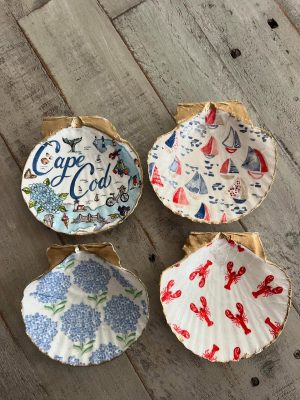 Pin
Pin Photo courtesy of What The Shell!
Once upon a time, these shells had rather serious jobs protecting soft-bodied oysters from hungry fish and tumbling tides. They spent decades layering nacre, that iridescent coating, like putting on armor one gossamer-thin sheet at a time. Then one day, the oyster departed, and the shell washed ashore to begin its second career as something far more whimsical.
Now they scoop caviar at fancy parties or measure out sea salt in cozy kitchens. Some become cheese spreaders that make even plain crackers feel elegant, while others turn into tiny serving dishes for olives or chocolates. The same curves that once fit snugly on ocean rocks now nestle perfectly in your palm when you’re stirring honey into tea.
What’s rather delightful is how the shell remembers its past life. Those natural ridges and valleys aren’t sanded away—they become part of the design. When you use a shell spoon, you’re holding something that still looks like it belongs to the sea, even as it’s helping you enjoy your morning yogurt. It’s functional nostalgia, if such a thing exists, and it tastes better than regular silverware somehow.
Trinket Dishes That Remember the Tide
 Pin
Pin Photo courtesy of St Ives, Cornwall
Small treasures have a habit of scattering themselves across every flat surface in your home, don’t they? Earrings hop off ears and land in the most impossible places, rings slide off soapy fingers and vanish into drain-adjacent danger zones, and bracelets tangle themselves into knots that would baffle sailors. But then along comes a shell-shaped solution that’s been waiting at the bottom of the sea all this time.
These oyster shell dishes sit on nightstands and bathroom counters like little guardians of your precious things. Their natural bowl shape, formed by years of ocean pressure, turns out to be perfectly sized for holding rings, coins, or those tiny earring backs that always try to escape. The pearlescent interior catches light from your bedside lamp and throws it back in soft rainbow ripples, making even Monday mornings feel a bit more magical.
The wonderful thing about these dishes is how they make organization feel less like a chore and more like curation. You’re not just dumping your jewelry into a boring bowl—you’re placing it in something that was once a home itself. Each shell has its own personality, with curves and colors that vary like fingerprints. Some gleam pure white, others blush pink or gray, and a few show streaks of green like watercolor paintings the ocean forgot to finish.
Candle Holders That Glow Like Underwater Lanterns
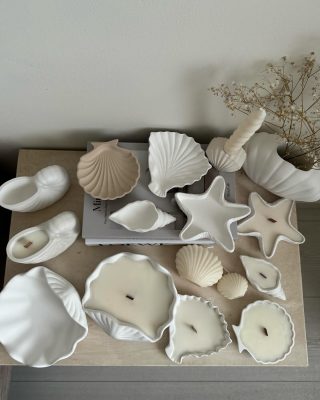 Pin
Pin Photo courtesy of Atelier Meysa
There’s something rather enchanting about fire dancing inside something born from water. When you nestle a tea light or small candle into an oyster shell, the flame flickers against that pearl-lined interior and creates shadows that seem to breathe. The light bounces off all those tiny ridges the oyster spent years building, and suddenly your dining table looks like it’s hosting a gathering for merfolk.
These shell candle holders work beautifully because the oyster already did most of the design work. That natural cup shape cradles votives perfectly, and the thick calcium walls keep surfaces safe from heat. Some people float them in shallow bowls of water for dinner parties, and the shells bob gently like tiny illuminated boats. Others cluster several along a windowsill, where they catch both candlelight and moonlight in their pearly depths.
What makes them so special as gifts is how they transform an everyday item into something that feels ceremonial. A plain candle is nice enough, but a candle glowing inside a shell that once lived beneath waves? That’s the sort of thing that makes bath time feel like a spa ritual, or turns a regular Tuesday dinner into something worth remembering. They cost less than a movie ticket but create moments that flicker in memory long after the wax melts away.
Soap Dishes That Don't Mind Getting Wet
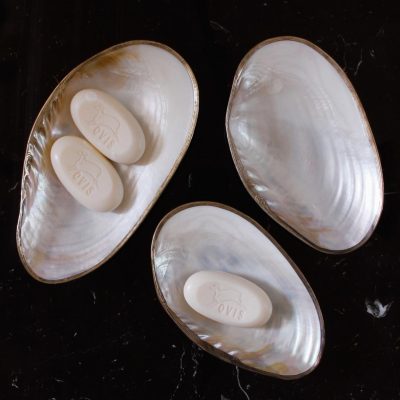 Pin
Pin Photo courtesy of Water and Wood
Here’s a funny bit of irony: the thing that spent its entire life underwater turns out to be brilliant at keeping your soap dry. Oyster shells naturally drain water through their ridges and grooves, those little channels carved by years of tidal flow. Place your bar soap inside one, and the water trickles away instead of turning your expensive lavender soap into mush at the bottom of a ceramic dish.
The shells seem almost designed for this purpose, though of course they weren’t thinking about bathroom décor when they were busy filtering plankton. Their slightly rough texture keeps soap from sliding around, and that natural tilt most shells have means water runs right off the edge. Plus, they’re completely waterproof in a way that makes sense when you remember where they came from. A little soap scum rinses away easily, and they dry quickly between uses.
What’s lovely about using shells as soap dishes is how they make your sink area feel like a seaside retreat without trying too hard. There’s no nautical theme required, no striped towels or anchor motifs needed. Just one beautiful shell doing what it does naturally, which happens to involve keeping your handmade honey oat soap in perfect condition. They nestle beside any faucet like they’ve always belonged there, turning a boring bathroom necessity into something that makes you smile when you wash your hands.
Salt Cellars That Season With Style
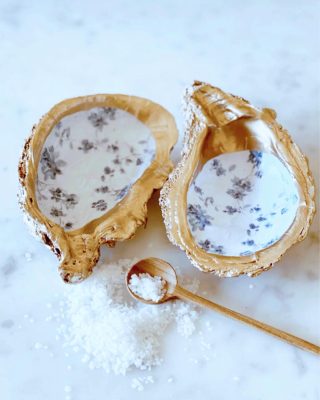 Pin
Pin Photo courtesy of Merritt Buchanan home
Salt has been precious throughout history, once traded like currency and hoarded like gold. So it seems rather fitting that something equally valuable from the sea should hold it. Oyster shells make wonderful salt cellars—those little pinch bowls chefs keep by the stove—because their size is just right for grabbing a three-finger pinch of flaky sea salt or coarse pepper. Your hand reaches in naturally, and the smooth interior doesn’t scratch your fingers the way some rough ceramic bowls can.
The shells work brilliantly for this purpose because they’re non-reactive, meaning they won’t affect the flavor of your salt the way some metals might. They’re also surprisingly sturdy, not likely to tip over when you’re cooking at speed and reaching for seasoning mid-stir. That natural weight keeps them planted on your counter, and the pearl shine inside makes even ordinary table salt look like something special you might have mined from a Himalayan cave.
What transforms them from practical to delightful is how they make cooking feel more intentional. When you reach for salt held in something that once filtered ocean water, there’s a pleasing sort of symmetry to it. You’re seasoning your dinner with salt that came from the sea, stored in a vessel that lived there. They cost about the same as a jar of fancy spice but last forever and never need refilling—just a quick rinse when they get dusty.
Serving Dishes for Appetizers That Start Conversations
When guests arrive for dinner and you bring out appetizers served in actual oyster shells, something delightful happens. People pause mid-reach for the cheese and ask where you found such charming little plates. Suddenly you’re not just serving crackers and spreads—you’re serving them with a story attached, and everyone wants to know if you collected the shells yourself or discovered them at some hidden market stall.
These shells work wonderfully as individual serving vessels because they’re naturally portion-sized. One shell holds just enough tapenade or herbed butter or smoked salmon for a single guest, which somehow makes everything taste more special. The curved shape cradles sauces without spilling, and that rough exterior provides a nice textural contrast to smooth dips. They nest together beautifully on a platter too, creating a display that looks far more impressive than the effort required, which was simply rinsing them and arranging them prettily.
The real magic happens when you realize how versatile they are. Use them for olives at cocktail hour, chocolate truffles after dinner, or even as tiny bowls for dipping sauces alongside sushi. They’re easier to clean than you’d think—just warm soapy water and a soft brush—and they stack neatly in cupboards between parties. For the price of a few fancy paper napkins, you’ve got serving dishes that make every gathering feel a bit more sophisticated and a lot more memorable.
Jewelry Organizers That Sparkle Back at You
Jewelry has a mind of its own, doesn’t it? Necklaces tangle themselves into impossible knots overnight, earrings separate from their partners like they’re in a quarrel, and rings roll under furniture where they plot their escape into the floorboard gaps. But oyster shells seem to understand jewelry’s wandering nature because they offer the perfect compromise between freedom and containment.
The mother-of-pearl lining inside each shell creates this rather wonderful effect where your jewelry sits against a surface that’s nearly as pretty as the pieces themselves. Silver rings gleam against that rainbow shimmer, gold catches the light and throws it back doubled, and gemstones seem to glow more brightly when they’re resting in something that once grew its own pearls. It’s like jewelry recognizing a distant cousin and settling down contentedly beside it.
What makes these shells brilliant for organization is how you can use several together without things looking cluttered. One shell for rings, another for earrings, a third for bracelets—suddenly your dresser top becomes a curated display instead of a chaotic pile. They’re shallow enough that you can see everything at a glance when you’re getting dressed, but deep enough that things don’t roll out when you bump the furniture. And because each shell looks slightly different, you’ll never confuse which one holds what, even before your morning coffee kicks in.
Ring Holders for Beside the Sink
You know that moment of panic when you’re washing dishes and suddenly realize your wedding ring is still on your finger, soap suds creeping dangerously close to making it slip down the drain? Or when you’re kneading bread dough and remember too late that your grandmother’s ring is about to get coated in sticky flour? That’s where a small oyster shell stationed beside your kitchen sink becomes a tiny hero in your daily routine.
These shells work perfectly as ring holders because they stay put on wet countertops. That textured outer surface grips surfaces instead of sliding around, and the cup shape is deep enough that rings won’t roll out if you knock the shell with your elbow while reaching for the dish soap. The inside stays relatively clean because water drains through those natural grooves, so your rings aren’t sitting in puddles between hand-washings. It’s like the shell remembers being surrounded by water and knows exactly how to handle it.
The sweetest part is how this simple solution prevents so much stress. No more removing rings and setting them on the counter edge where they might get swept into the trash, or balancing them on the faucet where they teeter dangerously. Just slip them into the shell, do your washing up, and retrieve them when your hands are dry. For something that costs less than a fancy hand soap, it saves you from that stomach-dropping moment when you can’t remember where you put your rings. And it looks charming doing it, which somehow makes dishwashing feel slightly less tedious.
Spoon Rests That Used to Be Homes
Cooking gets messy, doesn’t it? One moment you’re stirring a pot of tomato sauce, the next you’re looking for somewhere to set your dripping spoon that won’t stain the counter or require yet another dish to wash later. Most spoon rests are clunky ceramic things that take up too much space and somehow always end up in the wrong spot when you need them. But an oyster shell solves this problem with the sort of elegance that only nature seems capable of designing.
The shell’s natural curve cradles a wooden spoon or silicone spatula perfectly, catching drips in its bowl while the handle rests against the raised edge. That thick shell wall can handle heat from metal spoons fresh out of hot pans without cracking or scorching your countertop beneath it. And because the shells have texture on the outside, they don’t slide around on slippery counters the way smooth ceramic rests do. You can set your spoon down confidently and get back to cooking without worrying it’ll clatter to the floor.
What’s rather touching about using a shell this way is remembering what it used to do. This was once shelter for a living creature, protection against storms and predators and the crushing weight of deep water. Now it protects your counters from sauce splatters and provides a resting spot for the tools that feed your family. There’s a continuity there that feels right somehow, like the shell is still doing what shells do best, just in a kitchen instead of a tide pool.
Where These Ocean Treasures Come to Shore
Oyster shell crafts have a geography all their own, popping up wherever oysters grow abundant and creative hands see possibility in what others might toss aside. Coastal communities from Vietnam to France have been turning shells into useful objects for generations, each region adding its own flair. In places like coastal China and Korea, artisans have perfected the art of carving shell spoons and buttons for centuries, techniques passed down through families like precious recipes.
The craft thrives particularly in countries with strong oyster farming traditions. Japan produces exquisite shell pieces alongside its famous pearl industry, while regions along America’s Gulf Coast turn Louisiana oyster shells into everything from jewelry dishes to garden decorations. Vietnam and Thailand have bustling workshops where skilled craftspeople shape shells into cutlery and decorative items, often inlaid with additional mother-of-pearl for extra shimmer. Even Mediterranean countries like Greece and Italy, where oysters have been harvested since ancient times, have artisans who transform shells into kitchen tools and gift items.
What’s lovely about this global tradition is how it champions resourcefulness over waste. Instead of discarding millions of shells after oyster harvests, these communities give them second lives. The shells travel from fish markets to workshops to your home, carrying stories of tidal flats and fishing villages across oceans. When you buy one of these pieces, you’re often supporting small coastal economies where this craft keeps traditions alive and provides income for families who’ve worked with the sea for generations.
Caring for Shells That Care for Your Things
These shell pieces are surprisingly low-maintenance for something that once lived underwater, but they do appreciate a bit of gentle attention now and then. Warm soapy water and a soft cloth handle most cleaning jobs beautifully—just think of it as giving the shell a bath rather than scrubbing it like you would a stubborn pot. The mother-of-pearl interior can lose its luster if you attack it with abrasive cleaners or rough sponges, so treat it the way you’d treat good jewelry, with kindness and soft touches.
Most shells are quite durable, having survived years of ocean tumbling before reaching your home, but extreme temperature changes can make them crack. Don’t pop them in the dishwasher or leave them sitting in direct sunlight on a hot windowsill for hours on end. If you’re using them for food service, a quick rinse between uses keeps them fresh, and occasionally letting them air dry completely prevents any moisture from settling into tiny crevices. They’re rather forgiving about water since that’s where they came from, but they prefer room temperature experiences these days.
The wonderful thing about shell pieces is how they age gracefully when cared for properly. That pearl shine might mellow slightly over years of use, developing a softer patina that tells the story of all the honey it’s stirred or jewelry it’s held. Some people oil their shells occasionally with a tiny bit of mineral oil to keep that luminous glow, though honestly they’re beautiful even when they show their age. These aren’t items meant to stay perfect in a display case—they’re meant to be used, touched, and appreciated, gathering character along the way just like they did in the ocean.
FAQs
Yes! Shells tolerate heat well since they’re calcium-based. They work beautifully for warm dips or as spoon rests for hot utensils, though extreme temperature shocks might cause cracking over time.
Not at all. Properly cleaned shells are odorless. Any lingering sea scent disappears after the first wash, leaving just smooth, clean surfaces that smell like nothing at all.
Absolutely. Cleaned and polished shells are non-toxic and safe for food contact. They’re actually naturally antimicrobial, which is why oysters thrived in them for years in the first place.
With gentle care, they last for years—even decades. They’re surprisingly durable, having already survived ocean conditions. Just avoid harsh chemicals and extreme temperatures.
You can! Just clean them thoroughly by boiling, then let your creativity flow. Though artisan-made pieces often have polished interiors and refined edges that are tricky to achieve at home.



